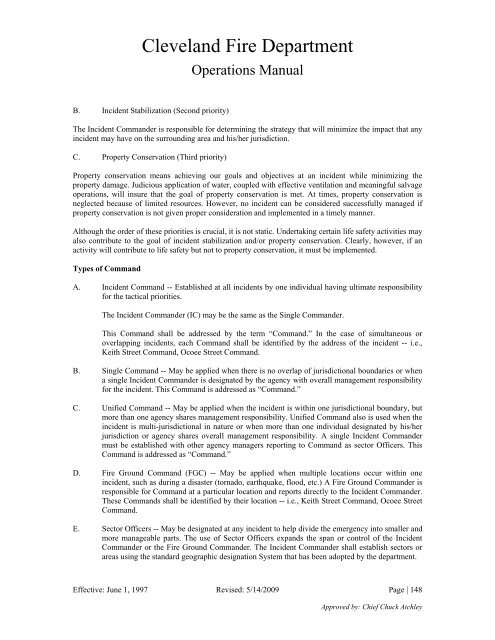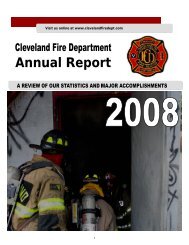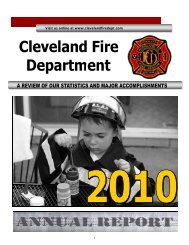SOP Manual - Cleveland Fire Department
SOP Manual - Cleveland Fire Department
SOP Manual - Cleveland Fire Department
- No tags were found...
Create successful ePaper yourself
Turn your PDF publications into a flip-book with our unique Google optimized e-Paper software.
<strong>Cleveland</strong> <strong>Fire</strong> <strong>Department</strong><br />
Operations <strong>Manual</strong><br />
B. Incident Stabilization (Second priority)<br />
The Incident Commander is responsible for determining the strategy that will minimize the impact that any<br />
incident may have on the surrounding area and his/her jurisdiction.<br />
C. Property Conservation (Third priority)<br />
Property conservation means achieving our goals and objectives at an incident while minimizing the<br />
property damage. Judicious application of water, coupled with effective ventilation and meaningful salvage<br />
operations, will insure that the goal of property conservation is met. At times, property conservation is<br />
neglected because of limited resources. However, no incident can be considered successfully managed if<br />
property conservation is not given proper consideration and implemented in a timely manner.<br />
Although the order of these priorities is crucial, it is not static. Undertaking certain life safety activities may<br />
also contribute to the goal of incident stabilization and/or property conservation. Clearly, however, if an<br />
activity will contribute to life safety but not to property conservation, it must be implemented.<br />
Types of Command<br />
A. Incident Command -- Established at all incidents by one individual having ultimate responsibility<br />
for the tactical priorities.<br />
The Incident Commander (IC) may be the same as the Single Commander.<br />
This Command shall be addressed by the term “Command.” In the case of simultaneous or<br />
overlapping incidents, each Command shall be identified by the address of the incident -- i.e.,<br />
Keith Street Command, Ocoee Street Command.<br />
B. Single Command -- May be applied when there is no overlap of jurisdictional boundaries or when<br />
a single Incident Commander is designated by the agency with overall management responsibility<br />
for the incident. This Command is addressed as “Command.”<br />
C. Unified Command -- May be applied when the incident is within one jurisdictional boundary, but<br />
more than one agency shares management responsibility. Unified Command also is used when the<br />
incident is multi-jurisdictional in nature or when more than one individual designated by his/her<br />
jurisdiction or agency shares overall management responsibility. A single Incident Commander<br />
must be established with other agency managers reporting to Command as sector Officers. This<br />
Command is addressed as “Command.”<br />
D. <strong>Fire</strong> Ground Command (FGC) -- May be applied when multiple locations occur within one<br />
incident, such as during a disaster (tornado, earthquake, flood, etc.) A <strong>Fire</strong> Ground Commander is<br />
responsible for Command at a particular location and reports directly to the Incident Commander.<br />
These Commands shall be identified by their location -- i.e., Keith Street Command, Ocoee Street<br />
Command.<br />
E. Sector Officers -- May be designated at any incident to help divide the emergency into smaller and<br />
more manageable parts. The use of Sector Officers expands the span or control of the Incident<br />
Commander or the <strong>Fire</strong> Ground Commander. The Incident Commander shall establish sectors or<br />
areas using the standard geographic designation System that has been adopted by the department.<br />
Effective: June 1, 1997 Revised: 5/14/2009 Page | 148<br />
Approved by: Chief Chuck Atchley




